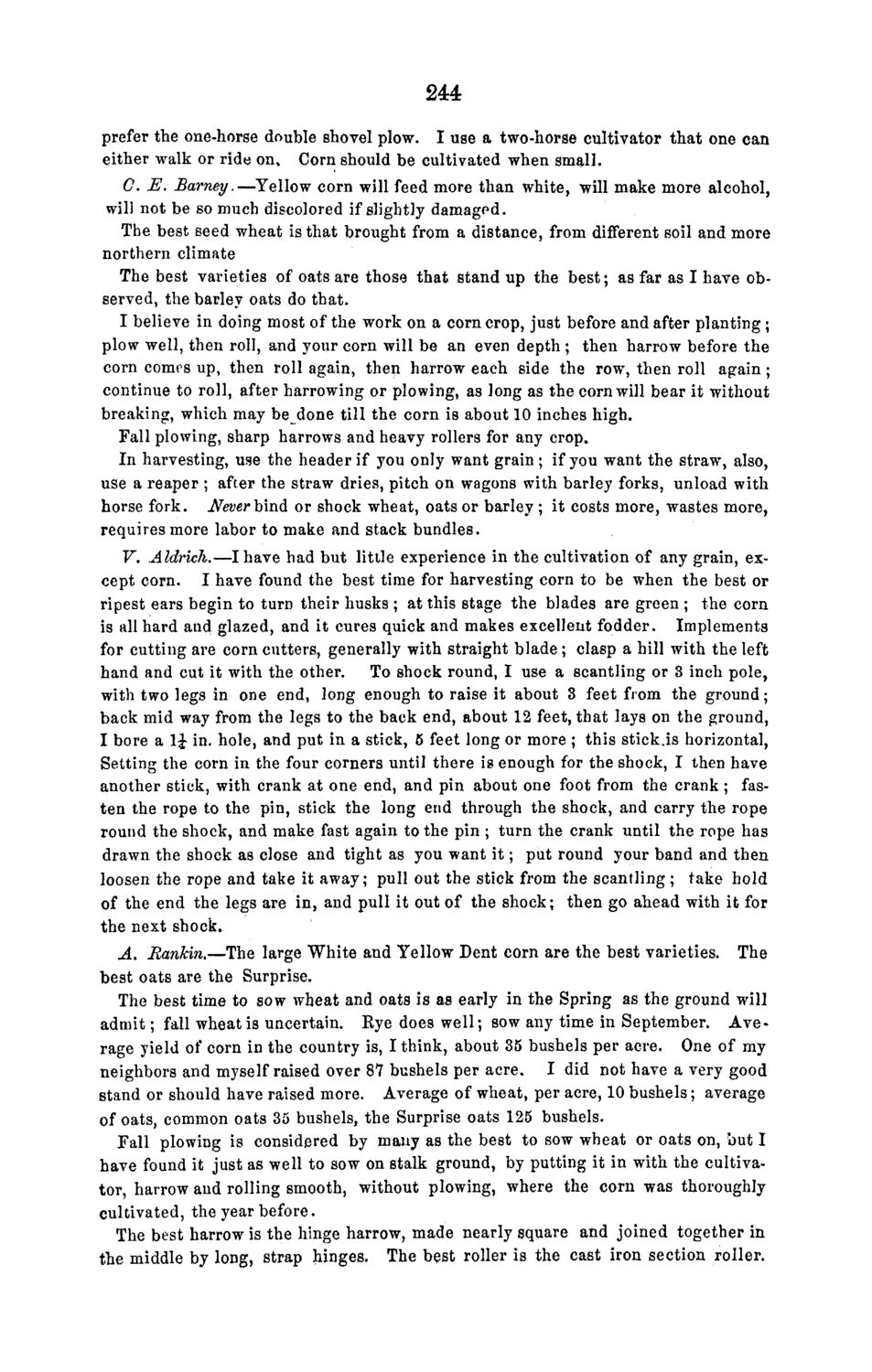| |
| |
Caption: Board of Trustees Minutes - 1868
This is a reduced-resolution page image for fast online browsing.

EXTRACTED TEXT FROM PAGE:
244 prefer the one-horse double shovel plow. I use a two-horse cultivator that one can either walk or ride on. Corn should be cultivated when small. C. E. Barney.—Yellow corn will feed more than white, will make more alcohol, will not be so much discolored if slightly damaged. The best seed wheat is that brought from a distance, from different soil and more northern climate The best varieties of oats are those that stand up the best; as far as I have observed, the barley oats do that. I believe in doing most of the work on a corn crop, just before and after planting; plow well, then roll, and your corn will be an even depth ; then harrow before the corn comes up, then roll again, then harrow each side the row, then roll again; continue to roll, after harrowing or plowing, as long as the corn will bear it without breaking, which may be done till the corn is about 10 inches high. Fall plowing, sharp harrows and heavy rollers for any crop. In harvesting, use the header if you only want grain; if you want the straw, also, use a reaper ; after the straw dries, pitch on wagons with barley forks, unload with horse fork. Never bind or shock wheat, oats or barley ; it costs more, wastes more, requires more labor to make and stack bundles. V. Aldrich.—I have had but little experience in the cultivation of any grain, except corn. I have found the best time for harvesting corn to be when the best or ripest ears begin to turn their husks ; at this stage the blades are green ; the corn is all hard and glazed, and it cures quick and makes excellent fodder. Implements for cutting are corn cutters, generally with straight blade ; clasp a hill with the left hand and cut it with the other. To shock round, I use a scantling or 3 inch pole, with two legs in one end, long enough to raise it about 3 feet from the ground; back mid way from the legs to the back end, about 12 feet, that lays on the ground, I bore a 1£ in. hole, and put in a stick, 5 feet long or more ; this stick.is horizontal, Setting the corn in the four corners until there is enough for the shock, I then have another stick, with crank at one end, and pin about one foot from the crank ; fasten the rope to the pin, stick the long end through the shock, and carry the rope round the shock, and make fast again to the pin ; turn the crank until the rope has drawn the shock as close and tight as you want i t ; put round your band and then loosen the rope and take it away; pull out the stick from the scantling ; take hold of the end the legs are in, and pull it out of the shock; then go ahead with it for the next shock. A. Rankin.—The large White and Yellow Dent corn are the best varieties. The best oats are the Surprise. The best time to sow wheat and oats is as early in the Spring as the ground will admit; fall wheat is uncertain. Rye does well; sow any time in September. Average yield of corn in the country is, I think, about 35 bushels per acre. One of my neighbors and myself raised over 87 bushels per acre. I did not have a very good stand or should have raised more. Average of wheat, per acre, 10 bushels; average of oats, common oats 35 bushels, the Surprise oats 125 bushels. Fall plowing is considered by many as the best to sow wheat or oats on, but I have found it just as well to sow on stalk ground, by putting it in with the cultivator, harrow and rolling smooth, without plowing, where the com was thoroughly cultivated, the year before. The best harrow is the hinge harrow, made nearly square and joined together in the middle by long, strap hinges. The best roller is the cast iron section roller.
| |